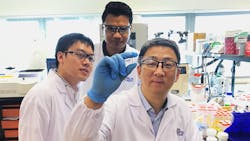Microfluidic chip quickly detects disease at low cost, without fluorescent labels
A team of researchers from the National University of Singapore (NUS) has developed a microfluidic chip that could effectively detect minute amounts of biomolecules without the need for complex lab equipment. The chip holds promise for a faster and cheaper way to diagnose diseases with high accuracy.
Related: Smartphone-driven lab-on-a-chip quickly detects multiple pathogens
Disease diagnostics involves detection and quantification of nano-sized bioparticles such as DNA, proteins, viruses, and exosomes (extracellular vesicles). Typically, detection of biomolecules such as proteins are performed using colorimetric assays or fluorescent labeling with a secondary antibody for detection, and requires complex optical detection equipment such as fluorescent microscopy or spectrophotometry.
One alternative to reduce cost and complexity of disease detection is the adoption of label-free techniques, which are gaining traction. However, this approach requires precision engineering of nano-features (in a detection chip), complex optical setups, novel nanoprobes (such as graphene oxide, carbon nanotubes, and gold nanorods), or additional amplification steps such as aggregation of nanoparticles to achieve sensitive detection of biomarkers.
"Our invention is an example of disruptive diagnostics," explains Zhang Yong from the Department of Biomedical Engineering at the NUS Faculty of Engineering, who led the work. "This tiny biochip can sensitively detect proteins and nano-sized polymer vesicles with a concentration as low as 10 ng/mL (150 pM) and 3.75 μg/mL, respectively. It also has a very small footprint, weighing only 500 mg and is 6 mm3 in size. Detection can be performed using standard laboratory microscopes, making this approach highly attractive for use in point-of-care diagnostics."
The fluorescent label-free approach uses the lateral shifts in the position of the microbead substrate in pillar arrays for quantifying the biomolecules, based on the change in surface forces and size, without the need of any external equipment. By using lateral displacement, the nano-biomolecules can be detected in real time and the detection is significantly faster when compared to fluorescent label-based detection.
"These techniques can also be extended to many other types of nano-biomolecules, including nucleic acid and virus detection," Zhang says. "To complement this chip technology, we are also developing a portable smartphone-based accessory and microfluidic pump to make the whole detection platform portable for outside laboratory disease diagnostics. We hope to further develop this technology for commercialization."
Full details of the work appear in the journal Nature Communications.

